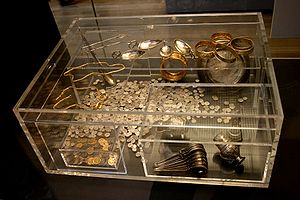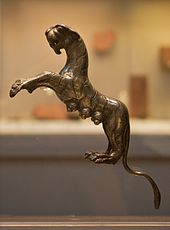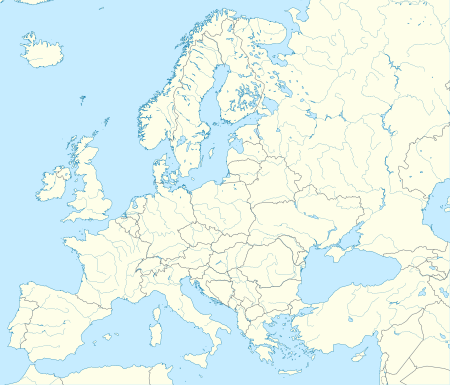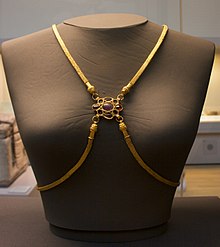Hoxne depository find
The Hoxne depot find ( English Hoxne Hoard ) is a late Roman hoard find consisting of more than 15,000 individual items , which was discovered on November 16, 1992 near Hoxne in England . It is the largest hoard of Roman coins from late antiquity on the British Isles to date . It is the largest collection of Roman gold and silver coins from the 4th and 5th centuries in the entire area of the Roman Empire at that time .
Find history
Location of the village of Hoxne in Suffolk in south-east England |
The hoard was discovered in a field about 1.5 miles from the village of Hoxne (pronunciation: Hoxn ) in Suffolk , England . After Peter Whatling, the tenant of the field, lost a hammer, he asked his friend Eric Lawes, a retired gardener and owner of a metal detector , to help him find the tool. Lawes found several silver and gold coins and everyday objects on November 16. He and Whatling then informed the local authorities and the police about the findings without carrying out any further excavations. The next day (November 17th) several archaeologists arrived, who in the following days lifted the treasure from the ground by excavating a block . The lost hammer was also found and is on display with the treasure in the British Museum .
The treasure was in one place. Thanks to the professional excavation by archaeologists, it was possible to precisely document the individual components of the hoard find in their spatial position relative to one another. In order not to attract robbery graves , the hoard was initially kept secret from the public. On November 19, 1992, however, the find was publicized by the tabloid The Sun and the British Museum was forced to give details of the find at a press conference on November 20, 1992. The preliminary archaeological conservation and the recording of the find were completed after about a month. The value of the treasure was estimated at around 1.75 million pounds in 1992 (equivalent to a current value of around 3.8 million euros). Under English law, the treasure because of would treasure shelf (treasure trove) automatically passed into the property of the Crown. However, it has been common practice for a long time to financially compensate the discoverer of a treasure (1996 was also a legal regulation with the Treasure Act ). Therefore, the sum of 1.75 million pounds was also paid out to Lawes as the discoverer of the treasure, who voluntarily shared the money in equal parts with Peter Whatling.
Scope of hoard
The finds consist of silver and gold coins, which together make up about 3.5 kg of gold and 23.75 kg of silver. The treasure was originally in an oak chest that was about 60 × 45 × 30 cm in size. Within the chest, individual objects were placed in smaller wooden vessels made of yew or cherry wood, while others were embedded in woolen cloth or straw. Except for fragments, however, the organic materials were completely decomposed.
The objects found consisted of:
- Coins:
- 569 gold coins ( solidi )
- 14,272 silver coins, including 60 miliarenses and 14,212 siliquae
- 24 bronze numbers
- Jewelery and utensils:
- 29 gold jewelry
- 98 silver spoons and ladles
- a tigress made of silver, which was worked as a handle or handle for a vessel
- 4 silver bowls and a small bowl
- 1 silver cup
- 1 silver vase
- 4 pepper shakers
- individual objects for personal hygiene, e.g. B. Toothpicks
- 2 silver locks as remnants of vessels made of wood or leather
- Traces of various organic materials, including a small Pyxis from ivory .
Finds in detail
Coins
Most gold and silver coins had a precious metal content of 95 to 99%, a few were forgeries with only the outer layer made of silver.
| The golden solidi of the Hoxne depot find were struck |
||||||||||||||||||||
|---|---|---|---|---|---|---|---|---|---|---|---|---|---|---|---|---|---|---|---|---|
|
The 569 golden solidi all date from the period between the beginning of the reign of Emperor Valentian I (from 364) to the reign of Honorius (393-423). The solidi were therefore only in use for a maximum of 50 years before they were deposited, and accordingly in a very good state of preservation. They came from a total of 14 different mints, which were spread over large areas of the Roman Empire at that time, with more than half coming from the mint Mediolanum and the period 394-402. Augusta Treverorum and Ravenna followed in second and third place . As a term post quem for the depositing of the treasure, the year 407/8 can be given due to the coinage, ie the depositing cannot be earlier than the year 407. The term ante quem , i.e. the point in time at which the coins must have been deposited at the latest , is much more difficult and can only be determined imprecisely and was estimated at the period 407-450.
| Clipped and unclipped siliquae from the Hoxne hoard |
||
|---|---|---|
 |
 |

|
| not clipped | moderately clipped | strongly clipped |
The 60 silver miliarienses were minted between the reigns of Constantine II (337-340) or Constantius II (337-361) and that of Arcadius (383-408). Among them were five variants unknown before the discovery. The oldest coin from the entire Hoxne treasure was also a miliariense . Of the 14,215 silver siliquae, two had the full precious metal content and 14,207 a reduced content, as was customary since about the year 358. Five more were semi- siliquae . In almost 2,500 siliquae, the time of the coinage could not be clearly determined. About 80% of the siliquae of the Hoxne treasure were clipped, i.e. H. a more or less small part of the edge had been deliberately removed (possibly gradually). This phenomenon is often found in late antique coins and the background and the period in which this occurred are controversial among historians. It was probably an attempt to extract small amounts of precious metal without deteriorating the face value of the coin. In addition, the flow of coins from the rest of the empire largely dried up after the Romans had largely withdrawn from Britain in 407 (see below). The 24 bronze coins could be assigned to the 4th century, but their state of preservation was so poor that a more precise classification was not possible.
Ornaments made of gold
In addition to the coins described, the hoard contained 29 other gold objects. It was all about jewelry. These pieces of jewelry consisted of an average of 91.5% gold (corresponds to about 22 carats ) with a total weight of about 1 kilogram and comprised a breast chain, six necklaces, three finger rings and 19 bracelets. The most important piece was a golden breast chain, which consisted of four finely braided individual chains, the ends of which were worked out into small lion heads and which are set on the breast with gemstones set in gold ( amethyst with surrounding garnet , four other stone settings, in which there may have been pearls empty) were held together. On the back, the jewelry chains were attached to a reworked golden solidus from the time of Gratian (375–383) with brackets . Similar breast chains are known from other parts of the Roman Empire and were worn as jewelry by women of high standing. The necklaces were mostly made more simply and partly decorated with animal figures (lions, dolphins). One chain was engraved with the monogram of Christ ( ☧ , Chi-Rho). The 3 finger rings had stone settings, but the gemstones they contained had obviously been removed before the treasure was deposited. The 19 bangles comprised three groups of four identical hoops each. A bracelet was the only one with an inscription ( VTERE FELIX DOMINA IVLIANE , see illustration). Others were decorated with geometric figures or hunting scenes. The lack of otherwise common pieces of jewelry, such as earrings and brooches, or jewelry pendants was noticeable.
Table accessories
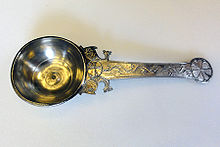
The considerable size of the find cannot hide the fact that some groups of table accessories are missing, such as the large plates from the Mildenhall treasure , the Kaiseraugst silver treasure or the Seuso treasure . In Hoxne there is a small jug and a corresponding mug made of silver.
The treasure includes numerous spoons of different shapes and decorations. There are those with a ladle-like spoon and disc-shaped end on the handle, but also those with a gooseneck as a handle and cochlearia . Some of the spoons have inscriptions that indicate different former owners. Christograms and the Christian inscription VIVAS IN DEO also appear.
The four objects called "Pepper pots" are extraordinary. These have small lockable sieves on the underside with which spices such as pepper can be sprinkled on the food at the table. One of the vessels is shaped like a dog tearing a hare; another that of an ibex. The bust of a female with a pigtail hairstyle is particularly elaborate. The fourth spice shaker (not shown here) shows the mythological battle between Hercules and Antaeus .
Historical context
The depositing of the treasure took place at a very troubled time in Britain. At the beginning of the 5th century, the entire Western Roman Empire was in a crisis (see Migration ). In the years 401–403 the Goths invaded Italy under Alaric and could only be repulsed with great effort (in 410 they even succeeded in taking and sacking Rome ). To defend Italy, troops (possibly the Legio XX Valeria Victrix ) had to be relocated from Britain. At the turn of the year 406/407 several Germanic tribes ( Vandals , Burgundians and Suebi ) as well as the Iranian Alans crossed the Rhine in relatively large numbers near Mogontiacum and penetrated the Roman area on the left bank of the Rhine and into Gaul. As a result, the system of Roman border defense on the Rhine collapsed, at least temporarily. Roman troops had to be withdrawn from Britain in a hurry to defend Gaul.
In connection with this crisis, there were several troop revolts in the Roman province of Britain, in which several counter-emperors were proclaimed by the Roman legions in quick succession ( Marcus † 406, Gratian † 406, and Constantine III. † 411). These counter-emperors were not generally recognized in the Western Roman Empire, but only ruled over part of it. In order to enforce his claim to power and to defend the Rhine border, Constantine III. in the year 407 with most of the troops of the field army devoted to him from Britain to Gaul, so that only a few Roman troops remained in Britain. As a result, an effective defense of the northern border on Hadrian's Wall against the Picts and Scots could no longer be maintained and these hostile tribes used the power vacuum that had developed in Britain for extensive raids. Attacks by Saxon pirates followed on the coasts . As a result, the Roman order partially collapsed. For a long time a letter from Emperor Honorius in Ravenna to the civitates of several British settlements from the year 410 was seen as the externally visible end point of Roman rule in Britain . They were asked to take their defense into their own hands, as Rome could not help them. However, it is disputed among historians whether this letter from Honorius was really addressed to the British or to residents of the Italian province of Bruttium .
After the withdrawal of the Roman troops, the Celtic-Roman aristocrat Vortigern , whose exact period of reign is unknown, rose to power the local area. The Roman social order and culture did not disintegrate immediately after the Romans withdrew from Britain, but continued to exist at the local level for a few decades (Sub-Roman Britain) . The longer phase of legal uncertainty that followed and the lack of central government power deprived them of their livelihoods in the long run. As a result of the power vacuum, members of the Germanic Angling , Saxon and Frisian tribes increasingly streamed into the country and settled there permanently. An alleged victory of the Saxons around 440 (at least according to the Gallic Chronicle of 452 ) then removed the last remnants of late Roman rule and the Celtic pre-inhabitants were increasingly pushed into the western fringes by the Germanic invaders.
The dumping of the Hoxne treasure should be seen against this historical background. With this collapse of the previous state order, wealthy people could no longer be sure of their privileges and property and tried to move their property to a safe place. It is possible that they would not have a chance to dig up the treasure again later and the knowledge of the hidden riches was lost. Another possibility is that the hoard is the hiding place of a robbery. Similar treasures from this period can be found across England. More than 95 such finds are known. The Hoxne find is particularly remarkable for its large size. All other clearly documented such finds comprised a maximum of only a few 100 coins. The largest gold coin find ever made in the British Isles was the Eye Treasure , just a few miles from Hoxne, discovered in 1780. This find comprised around 650 gold coins from the reigns of the emperors Valentinian I (364-375), Honorius (393-423) and Constantine III. (407–411), which, however, have not been archaeologically documented, so that the connection with the Hoxne depot find remains unclear. Possibly both finds are parts of a larger treasure. There is also a lack of scientific information about the extensive treasure trove of Cleeve Prior in Worcestershire from 1811, which is said to have comprised around 3,000 silver coins and around 500 gold coins from the same period and thus would have been the most extensive silver coin find in the entire Roman Empire from this period Work-up little known.
See also
literature
- Catherine Johns, Roger Bland: The Hoxne Late Roman Treasure . In: Britannia 25, 1994, pp. 165-173 ( JSTOR 526995 ).
- Peter SW Guest: The Late Roman Gold and Silver Coins from the Hoxne Treasure. British Museum Press, London 2005, ISBN 0-7141-1810-9 .
- Catherine Johns: The Hoxne Late Roman Treasure. Gold Jewelery and Silver Plate . British Museum Press, London 2010, ISBN 978-0-7141-1817-8 .
Web links
Individual evidence
- ↑ Hoxne pepper pot. BBC News / British Museum, accessed November 22, 2013 (English). ; The Hoxne Hoard. The British Museum, accessed November 22, 2013 .
- ↑ a b C.A .: Hoxne Hoard. Current Archeology, October 1, 2010, accessed November 22, 2013 .
- ↑ The Sun published the news of the find on the front page of its November 19 issue and promised to draw a metal detector among those who answered the following question correctly: “Who built Hadrian's Wall? Hadrian, Barretts or Wimpey? ”.
- ↑ Stephen Goodwin: Plan to extend protection for buried treasure. The Independent, March 9, 1996, accessed November 22, 2013 .
- ↑ a b c d e f g h i j k l Catherine Johns, Roger Bland: The Hoxne Late Roman Treasure . In: Britannia 25, 1994, pp. 165-173. JSTOR 526995
- ↑ Making money: Five life-changing finds from a walk in the wild. The Telegraph, February 1, 2013, accessed November 23, 2013 .
- ^ Peter SW Guest: The Late Roman Gold and Silver Coins from the Hoxne Treasure. British Museum Press, London 2005, ISBN 0-7141-1810-9 .
- ^ Edward A. Thompson : Zosimus 6.10.2 and the Letters of Honorius. In: The Classical Quarterly , 32, 1982, pp. 445-462 JSTOR 638584 .
- ^ Anne S. Robertson: An Inventory of Romano-British Coin Hoards . Royal Numismatic Society, London 2000, ISBN 0-901405-48-5 , p. 404.
Coordinates: 52 ° 20 ′ 0 ″ N , 1 ° 11 ′ 0 ″ E
